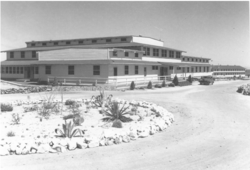
The Presidio of San Francisco is a park and former U.S. Army post on the northern tip of the San Francisco Peninsula in San Francisco, California, and is part of the Golden Gate National Recreation Area.

The National Trust for Historic Preservation is a privately funded, nonprofit organization based in Washington, D.C., that works in the field of historic preservation in the United States. The member-supported organization was founded in 1949 by congressional charter to support the preservation of America’s diverse historic buildings, neighborhoods, and heritage through its programs, resources, and advocacy.

Sierra Vista is a city in Cochise County, Arizona, United States. According to the 2020 Census, the population of the city is 45,308, and is the 27th most populous city in Arizona. The city is part of the Sierra Vista-Douglas Metropolitan Area, with a 2010 population of 131,346. Fort Huachuca, a U.S. Army post, has been incorporated and is located in the northwest part of the city. Sierra Vista is bordered by the cities of Huachuca City and Whetstone to the north and Sierra Vista Southeast to the South.

Buffalo Soldiers were United States Army regiments formed during the 19th century to serve on the American frontier that primarily comprised African Americans. On September 21, 1866, the 10th Cavalry Regiment was formed at Fort Leavenworth, Kansas. The nickname "Buffalo Soldiers" was purportedly given to the regiment by Native Americans who fought against them in the American Indian Wars, and the term eventually became synonymous with all of the African American U.S. Army regiments established in 1866, including the 9th Cavalry Regiment, 10th Cavalry Regiment, 24th Infantry Regiment, 25th Infantry Regiment and 38th Infantry Regiment.
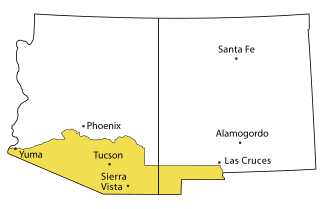
Southern Arizona is a region of the United States comprising the southernmost portion of the State of Arizona. It sometimes goes by the name Gadsden or Baja Arizona, which means "Lower Arizona" in Spanish.

Fort Huachuca is a United States Army installation, established on 3 March 1877 as Camp Huachuca. The garrison is now under the command of the United States Army Installation Management Command. It is in Cochise County in southeast Arizona, approximately 15 miles (24 km) north of the border with Mexico and at the northern end of the Huachuca Mountains, adjacent to the town of Sierra Vista. From 1913 to 1933, the fort was the base for the "Buffalo Soldiers" of the 10th Cavalry Regiment. During the build-up of World War II, the fort had quarters for more than 25,000 male soldiers and hundreds of WACs. In the 2010 census, Fort Huachuca had a population of about 6,500 active duty soldiers, 7,400 military family members, and 5,000 civilian employees. Fort Huachuca has over 18,000 people on post during weekday work hours.
America's 11 Most Endangered Places or America's 11 Most Endangered Historic Places is a list of places in the United States that the National Trust for Historic Preservation considers the most endangered. It aims to inspire Americans to preserve examples of architectural and cultural heritage that could be "relegated to the dustbins of history" without intervention.
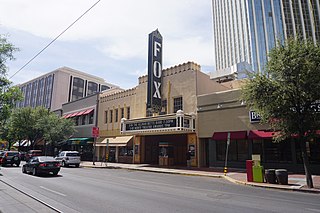
The Fox Tucson Theatre is located in downtown Tucson, Arizona, United States. The theater opened on April 11, 1930 as a performance space in downtown Tucson. It hosts a wide spectrum of events and concerts featuring a variety of performing talent, ranging from ballets, to jazz, contemporary pop, world music and rock acts.
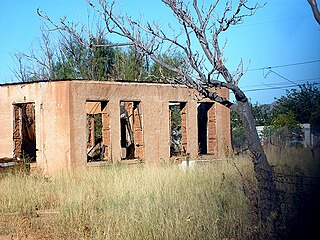
Fort Naco, Camp Naco, or Fort Newell began as a camp in the Southwest United States, on the outskirts of Naco, Arizona as part of the Mexican Border Project. Over time adobe and wooden buildings were constructed to house the garrison along with other permanent structures.

The Huachuca Mountains are part of the Sierra Vista Ranger District of the Coronado National Forest in Cochise County in southeastern Arizona, approximately 70 miles (110 km) south-southeast of Tucson and southwest of the city of Sierra Vista. Included in this area is the highest peak in the Huachucas, Miller Peak, and the region of the Huachucas known as Canelo Hills in eastern Santa Cruz County. The mountains range in elevation from 3,934 feet (1,199 m) at the base to 9,466 feet (2,885 m) at the top of Miller Peak. The second highest peak in this range is Carr Peak, elevation 9,200 feet (2,804 m). The Huachuca Mountain area is managed principally by the United States Forest Service (41%) and the U.S. Army (20%), with much of the rest being private land (32%). Sierra Vista is the main population center.
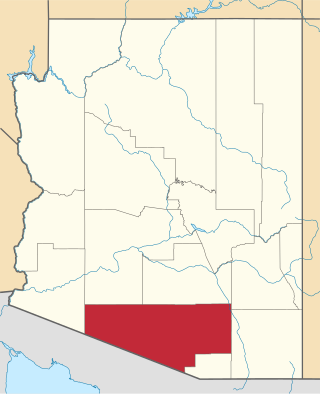
This is a list of the National Register of Historic Places listings in Pima County, Arizona.
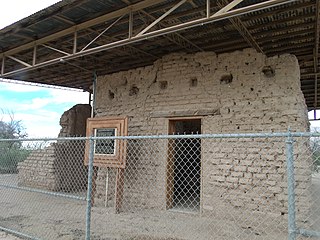
Fort Lowell was a United States Army post active from 1873 to 1891 on the outskirts of Tucson, Arizona. Fort Lowell was the successor to Camp Lowell, an earlier Army installation. The Army chose a location just south of the confluence of the Tanque Verde and Pantano creeks, at the point where they form the Rillito River, due to the year-round supply of water during that period. The Hohokam natives had chosen the site centuries earlier, presumably for the same reason. To this day, shards of Hohokam pottery can still be found in the area. The Army claimed a military reservation that encompassed approximately eighty square miles and extended east toward the Rincon Mountains.

Colonel Cornelius Cole Smith was an American officer in the U.S. Army who served with the 6th U.S. Cavalry during the Sioux Wars. On January 1, 1891, he and four other cavalry troopers successfully defended a U.S. Army supply train from a force of 300 Sioux warriors at the White River in South Dakota, for which he received the Medal of Honor. He was the last man to receive the award in battle against the Sioux, and in a major Indian war.
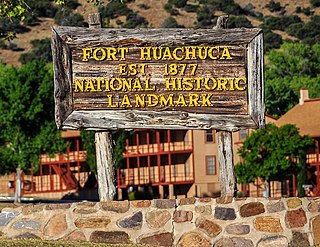
This is a list with images of some of the historic structures and places in the Fort Huachuca National Historic District in Arizona. The district, also known as Old Fort Huachuca, is located within Fort Huachuca an active United States Army installation under the command of the United States Army Installation Management Command. The fort sits at the base of the Huachuca Mountains four miles west of the town of Sierra Vista, on AZ 90 in Cochise County, Arizona.
The African American Cultural Heritage Action Fund is a program formed in 2017 to aid stewards of Black cultural sites throughout the nation in preserving both physical landmarks, their material collections and associated narratives. It was organized under the auspices of the National Trust for Historic Preservation. The initiative which awards grants to select applicants and advocates of Black history has been led by architectural historian Brent Leggs since 2019. It is the largest program in America to preserve places associated with Black history.

The Carver Center, formerly known as the Sunlight Elks Lodge, is a historic Colonial Revival style brick building located at 40 Fowler Street in the City of Trenton in Mercer County, New Jersey. It was named after George Washington Carver, African-American agricultural scientist and inventor. The building was added to the National Register of Historic Places on July 7, 2022, for its significance in ethnic heritage.

Las Saetas is one of the great examples of Pueblo Revival architecture in the American Southwest. Rebuilt in 1935 from the ruins of the 1873 Post Traders Store the design-build project was led by Dutch-born artist Charles Bolsius, with Nan and Pete Bolsius. The project included hand-carved doors, exposed beams, carved corbels, adobe fireplaces, hand-hammered tin, and a heightened sense of romanticism. The property and its transformation over a 150-year-span reflect the changing culture and economic milieu of Southern Arizona and the American West.

Charles Bolsius House, also called "Casa Bienvenidos", is a significant example of the architectural work of artist and designer Charles Bolsius and an important example of Territorial Revival design in the American Southwest. It is located in the City of Tucson, Arizona within the Old Fort Lowell Historic District.
